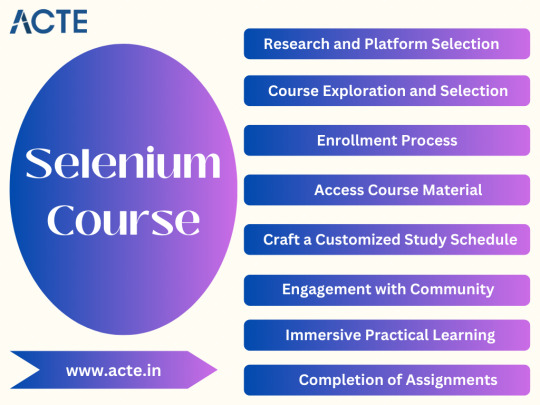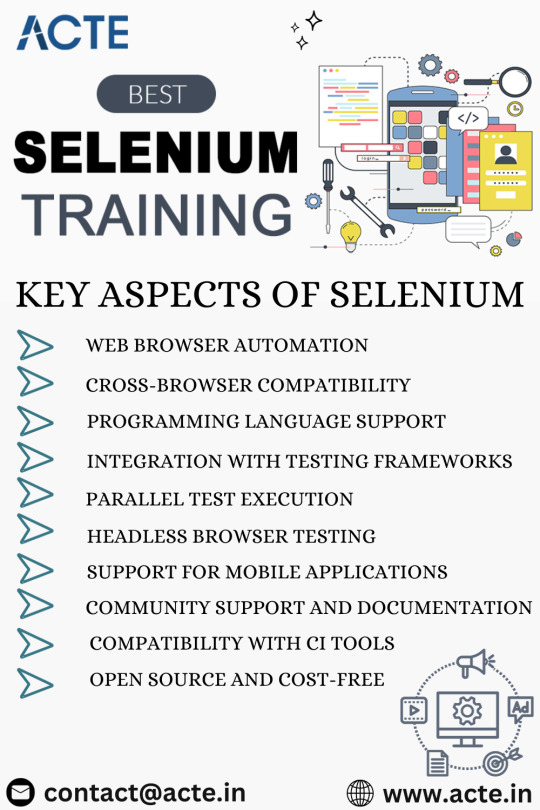#python and selenium tutorial
Explore tagged Tumblr posts
Text
AI Automated Testing Course with Venkatesh (Rahul Shetty) Join our AI Automated Testing Course with Venkatesh (Rahul Shetty) and learn how to test software using smart AI tools. This easy-to-follow course helps you save time, find bugs faster, and grow your skills for future tech jobs. To know more about us visit https://rahulshettyacademy.com/
#ai generator tester#ai software testing#ai automated testing#ai in testing software#playwright automation javascript#playwright javascript tutorial#playwright python tutorial#scrapy playwright tutorial#api testing using postman#online postman api testing#postman automation api testing#postman automated testing#postman performance testing#postman tutorial for api testing#free api for postman testing#api testing postman tutorial#postman tutorial for beginners#postman api performance testing#automate api testing in postman#java automation testing#automation testing selenium with java#automation testing java selenium#java selenium automation testing#python selenium automation#selenium with python automation testing#selenium testing with python#automation with selenium python#selenium automation with python#python and selenium tutorial#cypress automation training
0 notes
Text
Selenium with Python Tutorial: A Complete Beginner’s Guide

Introduction
Web automation has become a crucial skill in today's digital world, helping developers and testers automate repetitive tasks such as web testing, form submissions, data extraction, and more. Selenium with Python is one of the most powerful combinations for web automation, making it easier to interact with web applications programmatically.
This Selenium with Python tutorial is designed for beginners who want to learn how to automate web browsers efficiently. By the end of this guide, you will understand what Selenium is, why Python is a great choice for automation, and how you can start using Selenium for web testing and automation.
What is Selenium?
Selenium is an open-source automation framework used for testing web applications across different browsers and platforms. It allows developers and testers to simulate user interactions on a website, such as clicking buttons, filling out forms, navigating pages, and extracting information.
Key Features of Selenium:
Cross-Browser Testing – Supports multiple browsers like Chrome, Firefox, Edge, and Safari.
Multi-Platform Support – Works on Windows, macOS, and Linux.
Integration with Testing Frameworks – Can be used with frameworks like PyTest and Unittest for automated testing.
Headless Execution – Allows running tests in the background without opening a browser window.
Automated Web Scraping – Extracts useful data from websites efficiently.
Why Use Python for Selenium?
Python is one of the most popular programming languages for web automation because of its simplicity and extensive libraries. Here’s why Selenium with Python tutorial is a preferred choice for beginners and professionals:
Easy to Learn – Python has a simple syntax, making it ideal for beginners.
Rich Ecosystem – Offers numerous libraries and tools to enhance automation.
Fast Development – Requires fewer lines of code compared to other languages.
Active Community Support – A vast community of developers contributing to Python and Selenium.
Understanding Selenium Components
Selenium consists of several components that help automate web browsers effectively.
1. Selenium WebDriver
WebDriver is the core component of Selenium that interacts with web browsers. It allows automation scripts to perform actions like clicking buttons, entering text, and scrolling through pages.
2. Selenium Grid
Selenium Grid enables parallel execution of test cases on multiple browsers and operating systems simultaneously. It is useful for large-scale web testing.
3. Selenium IDE
A browser extension that records user interactions on a webpage and generates test scripts automatically. This is useful for beginners who want to learn Selenium without writing code initially.
4. Selenium Supported Browsers
Selenium supports all major web browsers, including:
Google Chrome
Mozilla Firefox
Microsoft Edge
Safari
Opera
Common Use Cases of Selenium with Python
Selenium is widely used across various domains for different purposes. Here are some common applications:
1. Automated Testing
Selenium helps developers test web applications by simulating user actions. This ensures the website functions correctly across different browsers and devices.
2. Web Scraping
With Selenium, users can extract data from dynamic websites that do not load content using traditional methods. This is useful for collecting market trends, pricing data, and more.
3. Form Filling and Data Entry
Selenium can automate tasks like filling out online forms, submitting surveys, or entering data into websites, saving time and reducing manual effort.
4. Automated Login and Navigation
Selenium allows users to automate login processes and navigate through websites programmatically, which is useful for testing authentication workflows.
5. Screenshot Capture
Developers and testers use Selenium to take automated screenshots of web pages for reporting and debugging purposes.
Challenges in Selenium Automation
While Selenium is a powerful tool, beginners might face some challenges when working with it:
1. Handling Dynamic Web Elements
Modern websites often use dynamic content that loads asynchronously. Identifying and interacting with such elements requires techniques like waiting for elements to appear.
2. Managing Browser Compatibility
Different browsers may render web pages differently. Ensuring cross-browser compatibility can be challenging without proper testing strategies.
3. Captcha and Bot Detection
Many websites implement security measures to prevent bots. Bypassing Captchas and handling bot detection mechanisms require additional tools.
4. Handling Pop-ups and Alerts
Web applications often contain pop-ups, alerts, and modal dialogs that need special handling during automation.
5. Maintaining Automation Scripts
Web pages frequently change, which may cause automation scripts to break. Regular updates and maintenance of test scripts are necessary to ensure reliability.
Best Practices for Using Selenium with Python
To effectively use Selenium for web automation, follow these best practices:
1. Use Explicit Waits
Instead of relying on fixed sleep times, use explicit waits to handle dynamic elements. This ensures better stability in test execution.
2. Keep Locators Unique and Reliable
Use stable locators like ID and CSS selectors to identify web elements. Avoid using XPaths that may change frequently.
3. Implement Logging and Reporting
Integrate logging mechanisms to capture test results and errors for better debugging.
4. Organize Test Scripts Properly
Follow a structured approach for writing automation scripts to improve maintainability.
5. Run Tests in Headless Mode When Needed
For faster execution, run Selenium tests in headless mode, especially in CI/CD pipelines.
Conclusion
This Selenium with Python tutorial provided an overview of how Selenium is used for web automation, why Python is a preferred language, and the key components that make Selenium a powerful tool. Whether you want to automate testing, scrape data, or perform repetitive web-based tasks, Selenium with Python offers a flexible and efficient solution.
By understanding its core concepts, best practices, and real-world applications, you can begin your journey into web automation with confidence. Start exploring Selenium today and take your automation skills to the next level! 🚀
0 notes
Video
youtube
Mastering Python Automation: Step-by-Step PyCharm Installation
#youtube#🚀 Exciting News! 🚀 We've started a Python Selenium tutorial on YouTube! 📺 If you're interested in learning for free simply click on the s
1 note
·
View note
Text
Mastering Advanced Python Interview Questions for Automation Testing

Mastering Advanced Python Interview Questions for Automation Testing
Introduction
Are you ready to take your software testing skills to the next level and ace your automation testing interviews? In this comprehensive guide, we'll delve into advanced Python interview questions tailored for automation testing roles. Whether you're aiming for a junior or senior position, these questions will help you showcase your expertise and land your dream job.
Table of Contents
Sr#
Headings
1
Introduction
2
Python and Selenium WebDriver Overview
3
Advanced Python Concepts
4
Python Decorators and Generators
5
Exception Handling in Python
6
Python Multithreading and Multiprocessing
7
Python Best Practices for Automation Testing
8
Python Libraries for Automation Testing
9
Advanced Python Functions
10
Conclusion
11
Frequently Asked Questions (FAQs)
Python and Selenium WebDriver Overview
Python's versatility and readability make it a popular choice for automation testing, especially when combined with Selenium WebDriver. Selenium WebDriver is a powerful tool for automating web applications, and Python's integration with Selenium makes it a go-to language for automation testers.
Advanced Python Concepts
To excel in Automation with Python , you need a deep understanding of advanced Python concepts. From decorators and generators to multithreading and multiprocessing, these concepts play a crucial role in writing efficient and maintainable automation test scripts.
Python Decorators and Generators
Decorators and generators are advanced Python features that can significantly enhance your selenium with python scripts. Decorators allow you to modify or extend the behavior of functions, while generators enable you to create iterators efficiently.
Exception Handling in Python
Exception handling is crucial in automation testing to ensure that your scripts can gracefully handle errors and unexpected situations. python selenium tutorial provides robust support for exception handling through try-except blocks, allowing you to write more robust and reliable test scripts.
Python Multithreading and Multiprocessing
Multithreading and multiprocessing are essential concepts for improving the performance of your automation testing scripts. python automation testing provides built-in libraries such as threading and multiprocessing to support these concurrency models.
Python Best Practices for Automation Testing
Following best practices is key to writing maintainable and efficient automation testing scripts. From using descriptive names for functions and variables to organizing your code into modules, these practices will help you write better automation tests.
Python Libraries for Automation Testing
python for automation testing offers a plethora of libraries and frameworks that can streamline your automation testing efforts. From unit testing frameworks like pytest to web scraping libraries like BeautifulSoup, these libraries can significantly enhance your automation testing workflow.
Advanced Python Functions
Understanding advanced Python function concepts such as lambda functions, map, filter, and reduce can make your automation testing scripts more concise and readable. These concepts allow you to write more expressive code and handle complex data transformations effectively.
Conclusion
Mastering advanced Automation Testing with Python interview questions is essential for excelling in automation testing roles. By familiarizing yourself with these concepts and practicing with real-world scenarios, you can demonstrate your expertise and stand out in your automation testing interviews.
Frequently Asked Questions (FAQs)
What are the key differences between Python 2 and Python 3?
Python 3 introduced several syntax changes and improvements over Python 2, including better Unicode support, syntax enhancements, and improved security features.
How can I improve the performance of my Python automation testing scripts?
To improve performance, consider using multithreading or multiprocessing to parallelize your tasks. Additionally, optimizing your code and using efficient data structures can also help improve performance.
What are some common pitfalls to avoid in Python automation testing?
Some common pitfalls include using hard-coded values instead of variables, neglecting error handling, and not considering edge cases in your test scripts.
How can I handle dynamic elements in Selenium WebDriver using Python?
You can handle dynamic elements in selenium webdriver python using techniques such as waiting for the element to be present, using explicit waits, or using dynamic locators to locate the element.
What are some best practices for organizing Python automation testing scripts?
Some best practices include organizing your code into modules and packages, using descriptive names for functions and variables, and writing clear and concise documentation for your scripts.
By mastering these advanced Python interview questions, you'll be well-equipped to tackle any automation testing interview with confidence. Start practicing these concepts today and take your automation testing skills to new heights!
#selenium webdriver#Automation with Python#python selenium tutorial#python automation testing#python for automation testing#Automation Testing with Python#selenium webdriver python
0 notes
Text
#Selenium Python Tutorial#selenium#tutorials#tutorials for beginners#selenium tutorial#selenium online training#Selenium#Selenium Online#selenium online training courses#selenium training course
0 notes
Text
Level Up Your Selenium Skills: The Ultimate Course for Test Automation
Are you looking to enhance your test automation skills and become a proficient Selenium user? Look no further! In this article, we will introduce you to the ultimate course that can help you level up your Selenium skills and take your test automation abilities to new heights. Whether you are a beginner or have some prior experience with Selenium, this course is designed to cater to all skill levels. So, let's dive into the details and explore the exciting journey of becoming a Selenium pro!

Why Test Automation Education Matters
In today's rapidly evolving IT industry, staying ahead of the curve is crucial for success. With software systems becoming increasingly complex, manual testing alone cannot keep up with the pace of development. Test automation has become a necessity to ensure the efficiency, accuracy, and scalability of testing processes.
By investing in test automation education, you empower yourself with the knowledge and skills required to excel in the competitive job market. Test automation specialists are in high demand, and having expertise in Selenium can open numerous career opportunities. Furthermore, by leveraging Selenium, you can save time, reduce effort, and deliver reliable results, making it an indispensable tool for any software tester.
The Power of Selenium in Test Automation
Selenium is a powerful open-source framework that has revolutionized the world of test automation. It provides robust capabilities for automating web browsers and enables testers to perform cross-browser testing effortlessly. With Selenium, you can write automation scripts in various programming languages like Java, Python, C#, and more. Its vast ecosystem of plugins and frameworks further extends its potential, making it the go-to choice for many automation professionals.
Key Features of Selenium
Selenium boasts a rich set of features that make it highly suitable for test automation. Some of the notable features include:
Cross-Browser Compatibility: Selenium allows you to test web applications across multiple browsers, ensuring your website functions flawlessly regardless of the platform.
Multi-Language Support: Selenium supports multiple programming languages, enabling you to choose your preferred language based on your comfort and project requirements.
Fast and Reliable: Selenium empowers you to execute tests swiftly and consistently, providing accurate results while maintaining the integrity of your automation suite.
Flexible and Extensible: Selenium's architecture allows you to integrate it with various frameworks and tools, providing flexibility in designing automation solutions that fit your specific needs.
Parallel Execution: Selenium allows you to run tests in parallel, significantly reducing execution time and enhancing productivity.
Community Support: Selenium enjoys a vast user community, providing ample resources, tutorials, and support when encountering challenges during automation implementation.

The Ultimate Course for Leveling Up Your Selenium Skills
Now that you understand the significance of Selenium in test automation, let's explore the ultimate course that can skyrocket your skills in this domain. This comprehensive course is designed by industry experts with extensive experience in test automation using Selenium. It covers everything from the fundamentals to advanced topics, ensuring a comprehensive and well-rounded learning experience.
Course Curriculum Highlights
Here's a glimpse of what you can expect to learn from this ultimate Selenium course:
Introduction to Selenium and its various components
Understanding Selenium WebDriver and its core functionalities
Hands-on exercises to master Selenium IDE and Selenium Grid
In-depth exploration of best practices for test automation using Selenium
Utilizing TestNG for efficient test case management and optimization
Advanced techniques for handling dynamic elements, AJAX, and other challenging scenarios
Integrating Selenium with frameworks like JUnit and Cucumber for improved test reporting and maintenance
Leveraging Selenium with Continuous Integration tools like Jenkins for seamless integration into the development pipeline
Exploring Selenium's compatibility with cloud platforms for distributed test execution
Target Audience and Prerequisites
Whether you are a beginner stepping into the world of test automation or a seasoned professional aiming to enhance your Selenium skills, this course caters to all skill levels. However, having a basic understanding of programming concepts and web technologies will be beneficial in grasping the core concepts effectively.
In conclusion, if you are looking to take your test automation skills to the next level, investing in the ultimate Selenium course at ACTE Technologies is the perfect choice. With Selenium's powerful capabilities and the comprehensive curriculum of this course, you will acquire the knowledge and expertise needed to excel in the field of test automation. So, why wait? Embark on this exciting journey and empower yourself with the skills that will set you apart in the competitive IT industry. Level up your Selenium skills and unlock endless opportunities!
8 notes
·
View notes
Text
Your Guide to the Best Python Training in Kochi: Building Skills for the Future
In an age where technology continues to reshape industries, learning to code has become more than a career asset—it's a necessity. Among all the programming languages available today, Python stands out due to its simplicity, flexibility, and wide range of applications. Whether you're aiming for a job in web development, data science, automation, or machine learning, Python is an essential language to master.
If you’re located in Kerala’s tech hub and searching for the best Python training in Kochi, this article will guide you through what to look for in a training program, why Python is an excellent choice, and how structured learning can significantly accelerate your career growth.
Why Python? The Language of the Present and Future
Python is widely regarded as the "beginner’s language," but its simplicity doesn’t mean it's limited in power. Some of the most complex and influential applications today—from Netflix’s recommendation engine to NASA’s workflows—are built on Python. Here’s why it has become the go-to language for developers and enterprises alike:
Readability & Simplicity: Python’s syntax resembles plain English, making it easier to learn and write clean, maintainable code.
Extensive Libraries: Whether it's data analysis (Pandas), machine learning (Scikit-learn, TensorFlow), web development (Django, Flask), or automation (Selenium, PyAutoGUI), Python has libraries for almost everything.
Large Community: With an enormous global user base, Python boasts a vibrant community. This ensures constant updates, support, and learning resources for both beginners and professionals.
High Demand: According to several job portals, Python developers consistently rank among the most sought-after professionals in India—and Kochi is no exception.
Career Opportunities After Python Training
The job market for Python professionals is expansive and growing. Some of the roles you can aspire to after completing a robust Python training program include:
Python Developer
Data Analyst
Data Scientist
Machine Learning Engineer
Backend Developer
Automation Engineer
DevOps Engineer
In Kochi, the demand for these roles is rising, with companies in Infopark, SmartCity, and even remote-based firms seeking skilled Python developers. Completing the Top Python training in Kochi equips you to capitalize on these opportunities.
Key Components of an Effective Python Training Program
To truly benefit from a Python course, it must go beyond syntax and offer practical, job-oriented training. Here's what to look for:
1. Foundational Concepts
The course should start with programming basics—variables, loops, conditionals, functions, data structures—before moving to complex topics.
2. Object-Oriented Programming (OOP)
OOP is a fundamental concept in software development, and mastering it in Python is crucial for building scalable applications.
3. Real-World Projects
Courses that include projects like building a web application, automating a workflow, or analyzing a dataset help reinforce learning and provide valuable portfolio pieces.
4. Web Development Training
Modules that cover Flask or Django are vital if you're planning to build web applications or work as a backend developer.
5. Data Handling and Analysis
Training should include working with files, databases (like SQLite or MySQL), and libraries like Pandas, NumPy, and Matplotlib for data visualization.
6. Exposure to Version Control
Using Git and GitHub is standard in the development industry, so practical exposure is essential.
7. Career Readiness
The best training programs also include resume building, mock interviews, and job placement support.
Classroom vs Online Training: Which is Better?
While online tutorials and YouTube videos are abundant, structured classroom or hybrid (offline + online) programs offer several advantages:
Focused Learning: You follow a structured path, unlike the scattered nature of self-learning online.
Direct Access to Instructors: Being able to ask questions and receive feedback in real-time speeds up learning.
Peer Interaction: Classroom setups offer group learning and the opportunity to network with fellow students.
Accountability: Scheduled classes and deadlines help keep you on track.
Better Doubt Resolution: It’s easier to clarify doubts and misconceptions in a live environment than waiting for responses in forums.
So, when you’re looking for the best Python training in Kochi, consider programs that offer both hands-on practice and real-time mentorship.
What Makes a Python Training Program Stand Out?
Given the number of training institutes and online platforms, here are signs of a high-quality program:
Up-to-date Curriculum: Python is evolving. The course should include modern frameworks, tools, and trends.
Qualified Instructors: Trainers with real-world development experience bring practical insights to the classroom.
Interactive Sessions: Courses should encourage participation and problem-solving, not just passive listening.
Capstone Projects: These serve as proof of your skills for job interviews and freelance opportunities.
Placement Support: A strong network with local and national companies gives students a head-start in job hunting.
Conclusion: Why ZOOPLE TECHNOLOGIES Offers the Best Python Training in Kochi
Among the many options available, ZOOPLE TECHNOLOGIES has emerged as a leader in providing the famous Python training in Kochi. What truly sets them apart is their commitment to job-oriented, practical training.
At ZOOPLE, Python training is more than just theory. Their carefully curated curriculum starts from scratch and advances to real-world applications—covering everything from basic syntax to full-stack development with Django and database integration. Students engage in live projects, receive 1:1 mentorship, and are trained on tools used by real developers in the industry.
The instructors at ZOOPLE TECHNOLOGIES are seasoned professionals who not only teach but mentor students through their learning and career journeys. With comprehensive placement support, resume workshops, and mock interviews, ZOOPLE ensures you're not just learning Python—you’re preparing for your future.
If you're truly looking for the best Python training in Kochi, where quality education meets career outcomes, ZOOPLE TECHNOLOGIES is your go-to destination.
0 notes
Text
The Advantages of Python: A Comprehensive Overview
Python has gained immense popularity in the programming world due to its simplicity, flexibility, and powerful capabilities. Considering the kind support of Python Course in Chennai Whatever your level of experience or reason for switching from another programming language, learning Python gets much more fun.

Whether you are a beginner stepping into coding or an experienced developer working on complex projects, Python offers numerous advantages that make it a preferred choice across various industries.
Easy to Learn and Use
Python is known for its clean and readable syntax, making it an excellent choice for beginners. Unlike other programming languages that require complex syntax, Python allows developers to write fewer lines of code while maintaining efficiency. Its simplicity ensures that even those without prior programming experience can quickly grasp the fundamentals and start coding.
Versatile Across Multiple Fields
One of Python’s biggest strengths is its versatility. It is used in web development, data science, artificial intelligence, machine learning, automation, game development, and even cybersecurity. This flexibility allows developers to transition between different domains without having to learn a new language.
Extensive Library and Framework Support
Python offers a vast collection of libraries and frameworks that simplify development tasks. Libraries like NumPy and Pandas are used for data analysis, TensorFlow and PyTorch for machine learning, Flask and Django for web development, and Selenium for automation. These libraries reduce the time and effort needed to build applications, allowing developers to focus on problem-solving.
Strong Community and Learning Resources
Python has a large and active global community that continuously contributes to its growth. Whether you need help debugging code, finding tutorials, or exploring best practices, numerous forums, documentation, and free learning platforms provide valuable support. This makes Python an ideal language for both self-learners and professionals. With the aid of Best Online Training & Placement Programs, which offer comprehensive training and job placement support to anyone looking to develop their talents, it’s easier to learn this tool and advance your career.

Cross-Platform Compatibility
Python is a cross-platform language, meaning it runs smoothly on Windows, macOS, and Linux without requiring major modifications. This feature enables developers to write code once and deploy it across different operating systems, saving time and effort.
Ideal for Automation and Scripting
Python is widely used for automating repetitive tasks, such as web scraping, file management, and system administration. Businesses leverage Python’s scripting capabilities to improve efficiency and reduce manual workloads. Many developers also use it to automate testing processes, making software development more streamlined.
High Demand in the Job Market
Python is one of the most sought-after programming languages in the job market. Companies across industries, including tech giants like Google, Amazon, and Microsoft, rely on Python for various applications. The demand for Python developers continues to grow, making it a valuable skill for those seeking career advancement.
Integration with Other Technologies
Python seamlessly integrates with other programming languages like C, C++, and Java, making it highly adaptable for different projects. This allows developers to enhance existing applications, optimize performance, and work efficiently with multiple technologies.
Conclusion
Python’s ease of use, versatility, and strong community support make it one of the best programming languages for both beginners and experienced developers. Whether you are interested in software development, data science, artificial intelligence, or automation, Python provides the tools and resources needed to succeed. With its continuous evolution and growing adoption, Python remains a powerful choice for modern programming needs.
#python course#python training#python#technology#tech#python online training#python programming#python online course#python online classes#python certification
0 notes
Text
What is the Best Automated Testing with Selenium Training?
In today's fast-paced software industry, automation testing has become a necessity. Selenium, the most popular automation testing tool, empowers testers to automate web applications effectively. If you are looking for the best Selenium training online, this guide will help you understand what makes a Selenium certification course valuable and how you can enhance your software testing skills.
Why Learn Selenium?
In today’s fast-paced software development world, automation testing has become a crucial element to ensure the quality and performance of applications. Among various automation testing tools, Selenium stands out as one of the most popular and widely used frameworks. But why should you learn Selenium, and what makes it the go-to choice for both beginners and experienced QA professionals? Let’s dive deeper into the reasons why mastering Selenium can be a game-changer for your career.
1. Industry Demand and High Employability
Selenium skills are highly sought after in the IT industry. With an increasing emphasis on agile practices and continuous integration/continuous deployment (CI/CD) pipelines, organizations are on the lookout for professionals who can automate testing efficiently. By learning Selenium, you become eligible for roles like Automation Tester, QA Engineer, and Test Lead, giving your career a significant boost.
2. Open-Source and Cost-Effective
One of the biggest advantages of Selenium is that it’s open-source and free to use. There are no licensing costs involved, making it accessible to individual testers and large enterprises alike. This cost-effective nature has made Selenium the top choice for automation across diverse industries, from finance to healthcare and e-commerce.
3. Cross-Browser and Cross-Platform Compatibility
Selenium supports multiple browsers (Chrome, Firefox, Safari, Internet Explorer, Edge) and platforms (Windows, Mac, Linux). This flexibility ensures that your automated tests can be executed across a wide range of environments, providing robust testing coverage for web applications.
4. Supports Multiple Programming Languages
Unlike many other automation tools, Selenium supports a variety of programming languages including:
Java
Python
C#
Ruby
JavaScript
Kotlin
This versatility allows testers to work with the language they are most comfortable with or the one most suitable for a given project.
5. Integration with Other Tools
Selenium seamlessly integrates with popular CI/CD tools such as Jenkins, Maven, and Docker. It also supports test management and reporting tools like TestNG and JUnit, making it an integral part of the DevOps ecosystem. Such integrations make Selenium indispensable for building robust and automated testing frameworks.
6. Rich Community Support
The vast community of Selenium developers and testers means that you will never be alone when facing challenges. Whether you need solutions to problems, tutorials, or updates on the latest features, the Selenium community provides ample support through forums, blogs, and open-source projects.
7. Real-World Applications and Hands-On Practice
Selenium is used by top companies worldwide, including Google, Facebook, Netflix, and Amazon, for automating web application testing. This means that mastering Selenium gives you practical skills that are directly applicable in real-world scenarios, increasing your value in the job market.
8. Career Growth and Salary Potential
Professionals skilled in Selenium often command impressive salaries. According to industry reports, Selenium testers with advanced skills and experience can earn significantly more than manual testers. The demand for automation testing continues to grow, making Selenium expertise a lucrative career investment.
9. Flexibility and Customization
Selenium’s architecture allows you to build customized frameworks and create robust test scripts tailored to specific project needs. You can write scripts to handle complex web elements, perform cross-browser testing, and even automate repetitive manual testing tasks.
10. Future-Proof Your Career
With the software industry moving increasingly towards automation and CI/CD practices, learning Selenium ensures that your skills stay relevant in the evolving IT landscape. Staying updated with the latest Selenium features and advancements will keep you ahead of the curve.
What to Look for in the Best Selenium Training Course?
Finding the right Selenium course training is crucial to mastering automation testing. Here’s what to consider:
1. Comprehensive Curriculum
A good Selenium course online should cover:
Selenium WebDriver basics and advanced concepts
Test automation frameworks (Hybrid, Data-Driven, Keyword-Driven, and POM)
Integration with CI/CD tools
Real-time project experience
Hands-on coding exercises
2. Hands-On Learning Approach
A practical Selenium certification training should include:
Live coding sessions
Step-by-step implementation of test cases
Real-world scenarios for better understanding
3. Expert Instructors
The best Selenium certification course should be led by industry experts with real-time automation testing experience. This ensures that learners gain insights into industry best practices.
4. Job-Oriented Training
A selenium software testing course should focus on industry-relevant skills, including:
Resume preparation and interview guidance
Real-world projects and use cases
Job placement assistance
5. Certification for Career Growth
A recognized Selenium certification course boosts your credentials and enhances job opportunities.
Key Components of the Best Selenium Course
1. Introduction to Selenium
Overview of Selenium and automation testing
Benefits and scope of Selenium in the industry
2. Selenium WebDriver
Setting up WebDriver
Locating elements using XPath, CSS Selectors
Handling different browser elements (buttons, dropdowns, alerts, popups)
3. Advanced Selenium Features
Handling multiple windows and tabs
Working with dynamic elements
File uploads and downloads
4. Test Automation Frameworks
Data-driven testing using Excel
Hybrid and keyword-driven frameworks
Page Object Model (POM) implementation
5. Continuous Integration & Deployment
Integrating Selenium with Jenkins
Running tests in parallel using Selenium Grid
Cross-browser testing
6. Real-Time Projects and Case Studies
Working on live applications
Debugging and reporting using industry tools
Industry Demand and Career Opportunities
According to job market analysis, the demand for Selenium automation testers is increasing. Companies across industries require skilled professionals in selenium software testing for continuous integration and deployment in Agile environments.
Job Roles for Selenium Professionals
Automation Test Engineer
QA Analyst
Software Developer in Test (SDET)
Test Architect
Salary Insights
Entry-level: $60,000 - $80,000 per year
Mid-level: $80,000 - $100,000 per year
Senior-level: $100,000+ per year
Conclusion
Mastering Selenium automation testing opens doors to lucrative career opportunities. Enroll in H2K Infosys' Selenium training online for hands-on experience, expert guidance, and career growth.
#Selenium Training#Selenium Training online#Selenium certification#Selenium certification training#Selenium certification course#Selenium course#Selenium course online#Selenium course training#selenium automation testing#selenium software testing
0 notes
Text
The Role of AI in Modern Software Testing Practices
AI is reshaping the way software testing is done. With AI automated testing, businesses can achieve higher efficiency, better accuracy, and faster software releases. Whether it’s AI software testing, AI generator testers, or AI-driven automation, the future of software testing is AI-powered.
#ai generator tester#ai software testing#ai automated testing#ai in testing software#playwright automation javascript#playwright javascript tutorial#playwright python tutorial#scrapy playwright tutorial#api testing using postman#online postman api testing#postman automation api testing#postman automated testing#postman performance testing#postman tutorial for api testing#free api for postman testing#api testing postman tutorial#postman tutorial for beginners#postman api performance testing#automate api testing in postman#java automation testing#automation testing selenium with java#automation testing java selenium#java selenium automation testing#python selenium automation#selenium with python automation testing#selenium testing with python#automation with selenium python#selenium automation with python#python and selenium tutorial#cypress automation training
0 notes
Text
Python: The Versatile and Powerful Programming Language
Introduction
Python is one of the most popular programming languages in the world. Known for its simplicity, readability, and versatility, it has gained widespread adoption across various industries. From web development and data science to artificial intelligence and automation, Python has proven to be a language that empowers developers and businesses alike.
In this blog post, we will explore the origins of Python, its key features, popular frameworks and libraries, use cases, and future trends.
History of Python

Python was created by Guido van Rossum in the late 1980s and officially released in 1991. Van Rossum, a Dutch programmer, developed Python as a successor to the ABC programming language. His goal was to create a language that emphasized code readability and efficiency.
Python has undergone several major updates:
Python 1.0 (1991): The first official release with core features like exception handling and dynamic typing.
Python 2.x (2000): Introduced list comprehensions and garbage collection.
Python 3.x (2008 — Present): A major overhaul that improved Unicode handling, print statements, and object-oriented programming.
Python 2 was officially deprecated in 2020, and all modern developments focus on Python 3.
Key Features of Python

Python’s popularity stems from its numerous advantages, including:
1. Easy to Learn and Read
Python’s syntax is clear and concise, making it an excellent choice for beginners. Its use of indentation enforces clean code structure.
2. High-Level Language
As a high-level programming language, Python handles complex programming tasks like memory management automatically.
3. Interpreted Language
Python does not require compilation, allowing developers to run code directly and get instant feedback.
4. Dynamically Typed
Variable types are determined at runtime, reducing the need for explicit declarations.
5. Extensive Standard Library
Python comes with a rich set of built-in libraries that simplify tasks such as file handling, networking, and mathematical computations.
6. Cross-Platform Compatibility
Python runs seamlessly on Windows, macOS, and Linux, making it a truly cross-platform language.
7. Object-Oriented and Functional Programming
Python supports multiple paradigms, allowing developers to write both object-oriented and functional code.
8. Strong Community Support
With an active global community, Python offers extensive documentation, tutorials, and third-party libraries.
Popular Python Frameworks and Libraries
Python’s power comes from its vast ecosystem of frameworks and libraries. Here are some of the most widely used ones:
Web Development

Django: A high-level web framework for building secure and scalable web applications.
Flask: A lightweight and flexible framework ideal for microservices and RESTful APIs.
FastAPI: Designed for high-performance API development.
Data Science & Machine Learning
Pandas: Used for data manipulation and analysis.
NumPy: Provides support for large, multi-dimensional arrays and matrices.
Scikit-learn: A machine learning library for data mining and predictive analysis.
TensorFlow & PyTorch: Popular frameworks for deep learning and neural networks.
Automation & Scripting
Selenium: Automates web browsing tasks.
BeautifulSoup: Scrapes data from websites.
PyAutoGUI: Controls the keyboard and mouse programmatically.
Cybersecurity & Ethical Hacking
Scapy: Used for packet manipulation and network scanning.
Requests: Handles HTTP requests efficiently.
PyCrypto: Provides cryptographic functions.
Game Development
Pygame: A library for developing simple 2D games.
Godot Engine (GDScript with Python-like syntax): A popular game development framework.
Finance & FinTech
Quantlib: Used for financial analytics and modeling.
Zipline: A backtesting framework for trading strategies.
TA-Lib: Provides tools for technical analysis of stock data.
Use Cases of Python

Python is widely used in various domains due to its versatility. Here are some key areas where Python plays a significant role:
1. Web Development
Python is used to build websites and web applications with frameworks like Django, Flask, and FastAPI.
2. Data Science & Analytics
Python is the primary language for data scientists, thanks to libraries like Pandas, NumPy, and Matplotlib.
3. Machine Learning & AI
With TensorFlow, PyTorch, and Scikit-learn, Python enables AI-driven applications such as facial recognition, natural language processing, and predictive analytics.
4. Cybersecurity & Ethical Hacking
Python is commonly used for penetration testing, network security, and malware analysis.
5. Game Development
Python’s simplicity makes it a great choice for prototyping and developing indie games.
6. Automation & Scripting
Python automates repetitive tasks like file management, data entry, and email processing.
7. Internet of Things (IoT)
Python is used in IoT applications for controlling smart devices and handling sensor data.
8. Finance & FinTech
Python is extensively used for stock market analysis, trading algorithms, and risk management.
Click here to see how it works
Future Trends in Python

Python continues to evolve with emerging technologies. Some exciting trends include:
1. AI and Machine Learning Dominance
Python remains the leading language for AI and machine learning applications, with ongoing improvements in TensorFlow and PyTorch.
2. Growth of WebAssembly (WASM) with Python
Python is expected to play a role in WebAssembly, making web applications faster and more efficient.
3. Python in Quantum Computing
Libraries like Qiskit and Cirq are driving Python’s presence in quantum computing research.
4. Enhanced Performance with PyPy
PyPy, an alternative Python implementation, is improving execution speed and memory efficiency.
5. Increased Use in Cybersecurity
As cybersecurity threats rise, Python’s role in ethical hacking and security analysis will expand further.
6. Edge Computing & IoT Expansion
Python’s adoption in IoT and edge computing will increase, supporting smart cities and automation.
7. Python for Blockchain Development
Python is being used to build blockchain applications and smart contracts.
0 notes
Text
The Seven Key Elements of Software Testing
The Seven Key Elements of Software Testing
Testing reveals that there are flaws.-python with selenium course
Testing enables us to show the presence of occurrences rather than their absence in a product. It is feasible to lessen the likelihood that incidents not yet identified will continue in the system after they have been reported and later fixed, but it is difficult to confirm and exceedingly improbable that there will be no occurrences at all.
Testing in its entirety is not feasible
Testing every conceivable set of data and activities across all of a software's features is typically not a practical option, barring exceptional circumstances, due to time, expense, or resource constraints. It is quite easy to take these elements into account while developing our strategy and creating test cases.
Initial testing - selenium and cucumber
This alliance is quite helpful when testing starts early in the software development process since it enables incidents to be found before the product fully develops. If these accidents weren't discovered until later stages, the cost of repair would be much higher.
Problem Clustering
When compared to the other components of a product, there are typically some modules and capabilities that are more prone to conceal issues (of higher priority). The 80/20 Rule, which claims that roughly 80% of results result from 20% of causes, is connected to this theory. This could be translated as follows in more exact terms: Not all software components are equally pertinent.
Paradox of pesticides
Repeatedly doing the same tests on a system's stable portion has a tendency to make it more difficult to find newly discovered incidents. Therefore, it is crucial that we continually examine and update our testing method as well as make sure that we thoroughly investigate all of the components that make up the product in order to maximize the likelihood of discovering events.
Testing depends on the situation
Depending on the system and the surroundings we want to verify, we will decide on the technique and the kinds of tests to run. For instance, testing for an e-commerce system will differ from testing for medical software. The techniques we employ
The fallacy of absence of errors
Assume that all the incidents that a certain system had noticed have now been resolved. After that, a fresh test cycle is run, after which additional instances are not found. However, the absence of any discovered mistakes does not necessarily suggest that the software is effective. This parameter does not represent its utility; rather, it measures how well a product can meet client expectations.
Understanding and putting these ideas into practice gives us a unique perspective that allows us to structure our testing strategy and work more accurately and efficiently.
Automate vs Manual Cross-Browser Testing: Explore the key differences in automation and manual software testing in our comprehensive Selenium automation with Python Join our Automation Testing Classes to master manual and automation software testing techniques, and earn a Certification for Test Automation to boost your career in quality assurance.
#python with selenium course#learn selenium with python#selenium with python course#python selenium course#selenium python course#learn python for selenium#selenium webdriver#selenium webdriver driver#python selenium tutorial#Selenium automation with Python#selenium webdriver python
0 notes
Text
How To Use Python for Web Scraping – A Complete Guide
The ability to efficiently extract and analyze information from websites is critical for skilled developers and data scientists. Web scraping – the automated extraction of data from websites – has become an essential technique for gathering information at scale. As per reports, 73.0% of web data professionals utilize web scraping to acquire market insights and to track their competitors. Python, with its simplicity and robust ecosystem of libraries stands out as the ideal programming for this task. Regardless of your purpose for web scraping, Python provides a powerful yet accessible approach. This tutorial will teach you all you need to know to begin using Python for efficient web scraping. Step-By-Step Guide to Web Scraping with Python
Before diving into the code, it is worth noting that some websites explicitly prohibit scraping. You ought to abide by these restrictions. Also, implement rate limiting in your scraper to prevent overwhelming the target server or virtual machine. Now, let’s focus on the steps –
1- Setting up the environment
- Downlaod and install Python 3.x from the official website. We suggest version 3.4+ because it has pip by default.
- The foundation of most Python web scraping projects consists of two main libraries. These are Requests and Beautiful Soup
Once the environment is set up, you are ready to start building the scraper.
2- Building a basic web scraper
Let us first build a simple scraper that can extract quotes from the “Quotes to Scrape” website. This is a sandbox created specifically for practicing web scraping.
Step 1- Connect to the target URL
First, use the requests libraries to fetch the content of the web page.
import requests

Setting a proper User-agent header is critical, as many sites block requests that don’t appear to come from a browser.
Step 2- Parse the HTML content
Next, use Beautiful Soup to parse the HTML and create a navigable structure.

Beautiful Soup transforms the raw HTML into a parse tree that you can navigate easily to find and extract data.
Step 3- Extract data from the elements
Once you have the parse tree, you can locate and extract the data you want.

This code should find all the div elements with the class “quote” and then extract the text, author and tags from each one.
Step 4- Implement the crawling logic
Most sites have multiple pages. To get extra data from all the pages, you will need to implement a crawling mechanism.

This code will check for the “Next” button, follow the link to the next page, and continue the scraping process until no more pages are left.
Step 5- Export the data to CSV
Finally, let’s save the scraped data to a CSV file.

And there you have it. A complete web scraper that extracts the quotes from multiple pages and saves them to a CSV file.
Python Web Scraping Libraries
The Python ecosystem equips you with a variety of libraries for web scraping. Each of these libraries has its own strength. Here is an overview of the most popular ones –
1- Requests
Requests is a simple yet powerful HTTP library. It makes sending HTTP requests exceptionally easy. Also, it handles, cookies, sessions, query strings, including other HTTP-related tasks seamlessly.
2- Beautiful Soup
This Python library is designed for parsing HTML and XML documents. It creates a parse tree from page source code that can be used to extract data efficiently. Its intuitive API makes navigating and searching parse trees straightforward.
3- Selenium
This is a browser automation tool that enables you to control a web browser using a program. Selenium is particularly useful for scraping sites that rely heavily on JavaScript to load content.
4- Scrapy
Scrapy is a comprehensive web crawling framework for Python. It provides a complete solution for crawling websites and extracting structured data. These include mechanisms for following links, handling cookies and respecting robots.txt files.
5- 1xml
This is a high-performance library for processing XML and HTML. It is faster than Beautiful Soup but has a steeper learning curve.
How to Scrape HTML Forms Using Python?
You are often required to interact with HTML when scraping data from websites. This might include searching for specific content or navigating through dynamic interfaces.
1- Understanding HTML forms
HTML forms include various input elements like text fields, checkboxes and buttons. When a form is submitted, the data is sent to the server using either a GET or POST request.
2- Using requests to submit forms
For simple forms, you can use the Requests library to submit form data
import requests

3- Handling complex forms with Selenium
For more complex forms, especially those that rely on JavaScript, Selenium provides a more robust solution. It allows you to interact with forms just like human users would.

How to Parse Text from the Website?
Once you have retrieved the HTML content form a site, the next step is to parse it to extract text or data you need. Python offers several approaches for this.
1- Using Beautiful Soup for basic text extraction
Beautiful Soup makes it easy to extract text from HTML elements.

2- Advanced text parsing
For complex text extraction, you can combine Beautiful Soup with regular expressions.

3- Structured data extraction
If you wish to extract structured data like tables, Beautiful Soup provides specialized methods.

4- Cleaning extracted text
Extracted data is bound to contain unwanted whitespaces, new lines or other characters. Here is how to clean it up –

Conclusion Python web scraping offers a powerful way to automate data collection from websites. Libraries like Requests and Beautiful Soup, for instance, make it easy even for beginners to build effective scrappers with just a few lines of code. For more complex scenarios, the advanced capabilities of Selenium and Scrapy prove helpful. Keep in mind, always scrape responsibly. Respect the website’s terms of service and implement rate limiting so you don’t overwhelm servers. Ethical scraping practices are the way to go! FAQs 1- Is web scraping illegal? No, it isn’t. However, how you use the obtained data may raise legal issues. Hence, always check the website’s terms of service. Also, respect robots.txt files and avoid personal or copyrighted information without permission. 2- How can I avoid getting blocked while scraping? There are a few things you can do to avoid getting blocked – - Use proper headers - Implement delays between requests - Respect robot.txt rules - Use rotating proxies for large-scale scraping - Avoid making too many requests in a short period 3- Can I scrape a website that requires login? Yes, you can. Do so using the Requests library with session handling. Even Selenium can be used to automate the login process before scraping. 4- How do I handle websites with infinite scrolling? Use Selenium when handling sites that have infinite scrolling. It can help scroll down the page automatically. Also, wait until the new content loads before continuing scraping until you have gathered the desired amounts of data.
0 notes
Text
Deciding Between Selenium with Python and Selenium with Java: An In-Depth Comparison
In the domain of automated testing, Selenium emerges as a pivotal tool for ensuring the reliability and quality of web applications. When it comes to selecting the programming language to harness Selenium's capabilities, two prominent contenders often come into play: Python and Java. Both languages offer distinct advantages and considerations, making the decision between them crucial for any automation project.

In this blog post, we'll conduct a thorough comparison of Selenium with Python and Selenium with Java, exploring their unique strengths, use cases, and factors to consider. By the end, readers will have a clearer understanding of which option aligns best with their project requirements, team proficiencies, and organizational objectives.
Python with Selenium:
Python, celebrated for its simplicity and readability, has garnered significant traction within the automation testing community. Let's delve into some key benefits of leveraging Python with Selenium:
Simplicity and Readability: Python's hallmark characteristics include simplicity and readability. Its concise syntax enables developers to express ideas in fewer lines of code, resulting in scripts that are easier to comprehend and maintain. For testers, this translates to expedited development cycles and reduced overhead in managing test suites.
Extensive Ecosystem: Python boasts a vast ecosystem of libraries and frameworks that complement Selenium, augmenting its capabilities for test automation. Whether handling data manipulation, conducting API testing, or generating test reports, Python's rich library support caters to diverse automation needs. Furthermore, the active Python community ensures an abundance of resources, tutorials, and documentation to aid testers throughout the automation journey.
Rapid Prototyping: Python's dynamic nature lends itself well to rapid prototyping and iterative development. Testers can swiftly experiment with different approaches, adapt scripts on-the-go, and respond promptly to evolving requirements. This flexibility seamlessly aligns with agile development methodologies, empowering teams to deliver high-quality software with agility.
Integration Compatibility: Python's interoperability with other tools and technologies makes it an appealing choice for Selenium automation. Whether integrating with continuous integration (CI) pipelines, test reporting frameworks, or version control systems, Python's versatility ensures smooth interoperability, streamlining the testing workflow and bolstering overall efficiency.

Java with Selenium:
Java, renowned for its robustness and performance, has long been a cornerstone in enterprise software development. Here are some compelling reasons to consider Java for Selenium automation:
Robustness and Performance: Java's static typing and strong object-oriented principles contribute to the robustness and performance of Selenium test suites. Its compile-time error checking aids in identifying potential issues early in the development phase, resulting in more stable and reliable automation scripts. For large-scale enterprise projects with stringent quality requirements, Java's reliability is a significant asset.
Widespread Adoption: Java enjoys widespread adoption within the enterprise landscape, making it a natural choice for organizations with existing Java codebases or a Java-centric development environment. The abundance of Java expertise in the workforce, coupled with extensive community support and industry recognition, solidifies its status as a preferred language for Selenium automation in many corporate settings.
Mature Tooling: Java's mature ecosystem of testing tools and frameworks, including JUnit and TestNG, seamlessly integrate with Selenium to offer comprehensive test automation solutions. These frameworks furnish advanced features such as parameterized testing, parallel execution, and built-in reporting capabilities, empowering testers to design and execute sophisticated test suites effortlessly.
Enterprise Support: Java's popularity in enterprise environments translates to robust support from vendors, extensive documentation, and a plethora of third-party integrations. For organizations seeking enterprise-grade features, reliability, and scalability in their Selenium automation endeavors, Java's ecosystem and support infrastructure present a compelling value proposition.
Conclusion:
In summary, both Selenium with Python and Selenium with Java present compelling options for test automation, each with its unique strengths and considerations. Python excels in simplicity, rapid development, and a vast ecosystem, making it an ideal choice for agile teams and projects with evolving requirements. Conversely, Java offers robustness, performance, and widespread enterprise support, rendering it well-suited for large-scale enterprise applications with stringent quality standards.
Ultimately, the decision between Python and Java for Selenium automation hinges on various factors such as project prerequisites, team proficiencies, and organizational preferences. By meticulously evaluating these factors and weighing the pros and cons of each option, stakeholders can make informed decisions that align with their specific needs and aspirations. Whether opting for the simplicity of Python or the robustness of Java, Selenium remains an indispensable tool for driving quality and efficiency in web application testing.
2 notes
·
View notes
Text
Beyond Clicks: Navigating the Landscape of Selenium for Developers
In the dynamic realm of software development, efficiency, and reliability are paramount. Selenium, an open-source framework, has emerged as a powerhouse for automating web browsers and streamlining the testing process. Embracing Selenium's capabilities becomes even more accessible and impactful with Selenium Training in Bangalore. This training equips individuals with the skills and knowledge to harness the full potential of Selenium, enabling them to proficiently navigate web automation challenges and contribute effectively to their respective fields.

Let's dive into the key features and benefits that make Selenium a go-to choice for developers and testers worldwide.
1. Web Browser Automation Simplified
At its core, Selenium is designed to automate web browsers, providing developers and testers with a suite of tools and libraries to script interactions with web elements. From clicking buttons to filling forms, Selenium allows for the programmatic simulation of user actions, significantly enhancing the efficiency of testing processes.
2. Cross-Browser Compatibility at its Core
One of Selenium's standout features is its ability to seamlessly work across different web browsers. Whether it's Chrome, Firefox, Safari, Edge, or others, Selenium ensures that web applications are rigorously tested and perform consistently across various browsers, a crucial aspect in today's diverse online landscape.
3. Versatility Across Programming Languages
Selenium supports a variety of programming languages, including Java, Python, C#, Ruby, and JavaScript. This versatility empowers developers and testers to leverage the language they are most comfortable with, fostering a seamless integration of Selenium into a wide range of development environments.
4. Integration with Testing Frameworks
Selenium effortlessly integrates with popular testing frameworks like JUnit, NUnit, TestNG, and more. This integration facilitates the creation of structured and maintainable test suites, enhancing the organization and execution of tests within the development workflow.
5. Parallel Test Execution for Efficiency
Selenium supports parallel test execution, enabling multiple tests to run simultaneously. This feature is a game-changer, significantly reducing testing time and optimizing resource utilization, especially in scenarios where efficiency is paramount.
6. Headless Browser Testing for Practicality
Selenium's support for headless browser testing allows tests to run without a graphical user interface. This is particularly valuable for scenarios where running a full browser is impractical or unnecessary, providing practical solutions for different testing needs.
7. Mobile Application Automation with Appium Integration
Beyond web applications, Selenium extends its capabilities to automate mobile applications through frameworks like Appium. This holistic approach enables end-to-end testing of both web and mobile applications, creating a unified testing solution.
8. Community Support and Robust Documentation
Selenium boasts a vibrant and active community that contributes to extensive documentation, tutorials, and forums. This community-driven support system ensures that users can easily seek help, share knowledge, and stay updated on the latest developments in Selenium.
9. Seamless Integration with Continuous Integration Tools
Selenium integrates seamlessly with popular Continuous Integration (CI) tools like Jenkins and Travis CI. This compatibility allows for the smooth incorporation of automated testing into the continuous integration and delivery pipelines, aligning with modern development practices.
10. Open Source and Cost-Free Advantage
Perhaps one of Selenium's most compelling features is its open-source nature. Being open source and free to use, Selenium eliminates financial barriers, making it accessible to a broad audience. The collaborative nature of Selenium's community ensures ongoing development and support for its users.

In conclusion, Selenium stands as a powerful and versatile framework that empowers developers and testers to automate web browsers and streamline testing processes. Its cross-browser compatibility, support for multiple programming languages, and integration with testing frameworks make it a cornerstone in the world of web automation. Whether you're a seasoned developer or a testing enthusiast, Selenium's capabilities, coupled with its open-source nature and vibrant community, make it an invaluable tool in the pursuit of efficient and reliable software development. To unlock the full potential of Selenium and master the art of web automation, consider enrolling in the Best Selenium Training Institute. This training ensures that individuals gain comprehensive insights, hands-on experience, and practical skills to excel in the dynamic field of web testing and automation.
3 notes
·
View notes
Text
How to Learn Python Quickly and Effectively
Python is one of the most popular programming languages, known for its simplicity and versatility. Whether you're a beginner or an experienced developer, learning Python efficiently can open up many career opportunities. Here’s a step-by-step guide to mastering Python quickly and effectively. Considering the kind support of Python Course in Chennai Whatever your level of experience or reason for switching from another programming language, learning Python gets much more fun.

Start with the Basics
Before diving into complex topics, it’s essential to build a strong foundation. Begin by learning Python’s core concepts:
Variables and data types (strings, integers, lists, dictionaries)
Conditional statements (if-else, loops)
Functions and modules
Object-oriented programming (OOP)
Free resources like W3Schools, Python.org, and GeeksforGeeks provide excellent tutorials to get started.
Take Online Courses for Structured Learning
Enrolling in structured courses can accelerate your learning process. Some great online courses include:
Python for Everybody (Coursera – University of Michigan)
Complete Python Bootcamp (Udemy – Jose Portilla)
Python for Beginners (Codecademy)
These courses offer interactive lessons and projects to help reinforce your learning.
Practice Coding Every Day
Consistent practice is key to mastering Python. Solve coding problems daily on platforms like:
LeetCode
HackerRank
CodeWars
Project Euler
Practicing real-world problems improves problem-solving skills and coding speed.
Work on Real-World Projects
The best way to learn Python is by building projects. Start with small projects such as:
A simple calculator
A web scraper using BeautifulSoup
A personal expense tracker
A to-do list application
Building hands-on projects helps you understand Python’s real-world applications and boosts confidence. With the aid of Best Online Training & Placement Programs, which offer comprehensive training and job placement support to anyone looking to develop their talents, it’s easier to learn this tool and advance your career.

Learn Python Libraries for Your Field
Depending on your interests, focus on relevant Python libraries:
Web Development: Flask, Django
Data Science: NumPy, Pandas, Matplotlib
Machine Learning: TensorFlow, Scikit-learn
Automation & Scripting: Selenium, BeautifulSoup
Learning domain-specific libraries will make you job-ready in your chosen field.
Read Python Documentation and Books
Deepen your knowledge by reading Python’s official documentation and books such as:
Python Crash Course by Eric Matthes
Automate the Boring Stuff with Python by Al Sweigart
These resources offer practical exercises and real-world coding examples.
Join Python Communities and Forums
Being part of a coding community helps in learning and networking. Some great Python communities include:
Stack Overflow
Reddit’s r/learnpython
Python Discord and Slack groups
Engaging in discussions and solving others’ queries can reinforce your knowledge.
Contribute to Open Source Projects
Collaborating on open-source projects on GitHub helps you gain real-world experience. You’ll learn to work with a team, write clean code, and improve debugging skills.
Improve Debugging and Code Optimization Skills
Understanding debugging techniques is crucial for writing efficient code. Use Python’s built-in debugging tools like print(), pdb, and logging. Writing optimized and clean code enhances performance.
Build a Portfolio and Showcase Your Work
Employers value hands-on experience. Create a GitHub profile and upload your Python projects. If possible, build a personal website to showcase your coding skills and attract job opportunities.
Final Thoughts
The key to learning Python quickly is consistency, practice, and real-world application. Follow a structured learning approach, engage with the coding community, and work on projects. With dedication, you can become proficient in Python in just a few months.
#python course#python training#python#python programming#python online course#python online training#python online classes#python certification
0 notes